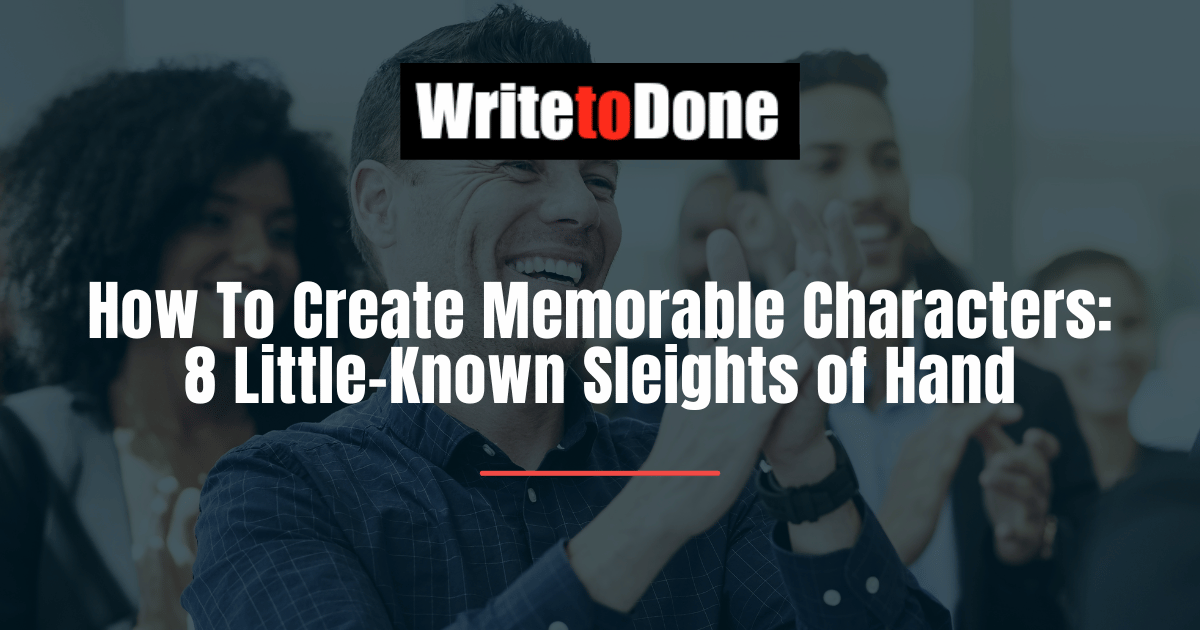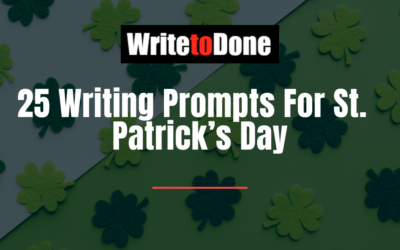Do we always have to create memorable characters?
No.
It depends on the genre.
In an all-action thriller focused on pace and plot, everyone but the key players can be wafer-thin. They’re disposable.
The same is often true of detective fiction, even the quality sort. In John Dickson Carr’s famous ‘locked room’ mysteries, the only rounded character is the sleuth, Gideon Fell, and he’s larger than life. All the other players are pawns on a chessboard.
But what if we do want to bring our characters alive–make them colorful?
Here are eight tips that will help you to create memorable characters.
1. Use Character Labels
Do we remember characters who are introduced with a bald description?
‘He was a short man, stubby, with a protruding chin.‘
Probably not.
So why mention those details at all, unless they’re important to the story?
Because we can use them later as labels.
‘His face appeared at my elbow‘; ‘The stubby man entered‘; ‘He poked his long chin at me.’
And so on.
However, characters who are identified by labels alone have no personality. That’s just as well if they quickly vanish from the tale or meet a nasty end.
But what of the others?
A fast way to make characters – minor or not – more memorable is to dress them in a metaphor as soon as they appear.
‘My first impression of Fergus Lafferty was of a furze bush. Tall, prickly and bent by the wind.‘
Then keep playing on that metaphor whenever you refer to the character:
‘The furze bush glowered’; ‘He walked unsteadily, bent by the wind.’
The first visual snapshot usually defines the character, just as first appearances do in life. Of course, first appearances can be deceptive. (Jess, a squint-eyed shrew, really has a heart of gold etc.)
Language then expands the character snapshot.
How often have we read stories where everyone uses the same bland idioms? A great opportunity for characterization is lost.
But we don’t have to push language to the point of quirks and caricature to distinguish a character. A mere change of cadence can do it.
Here’s a puritan vicar, described as ‘lank, shabby, proudly erect:’
“Who was the thief I cannot tell, and it is not for me, a priest, to seek him out.”
His short block-like phrases replicate his rigid mind. They contrast with the breezy speech rhythms of the detective he’s addressing: Reggie Fortune, a whimsical man.
‘Reggie laughed. “My dear chap! Oh, my dear chap!”’ (H. C. Bailey, Mr Fortune Explains)
Character labels can be great fun, especially if we add descriptions of dress, mannerism, occupation, and the like.
Then we’ve created rounded characters, haven’t we?
Not yet. Only flat characters.
They may be memorable, even colorful, but they lack life.
So how do we raise our game?
Here are seven far more subtle tips. All depend on ‘shadow’ characterization, the ability to say important things obliquely.
2. Bring in a Doppelganger
This is guilt by association.
The character reminds the narrator of someone else, quite by chance. Or the character brings to mind an unrelated incident.
We can do it blatantly: ‘S/he was a typical nerd [drop in your term of choice].’
Or indirectly:
‘He put me in mind of my cousin Joe – all smiles, but the soul of a weasel.’
‘For some reason, she made me feel like a foolish child.’
‘The last time I’d heard someone laugh like that was in high school when the class bully dropped a lizard down my shirt.‘
3. Use the Knock-on Effect
If the reader has already formed a strong opinion – positive or negative – about the narrator or another character, their opinion of a third party will be colored by that person’s opinions.
Suppose the village shopkeeper, an honest man, whispers to the narrator:
“I don’t like that young fellow who’s just moved into the cottage. Stuck-up city type. Thinks he’s too good for the likes of us.”
The reader is inclined to dislike him too.
Or a bigoted old lawyer describes a new woman barrister in his chambers, sniffily, as:
“Our token bit of skirt.”
At once, we feel sympathetic towards that woman.
(Needless to say, the reader’s opinion – in both cases – might be shockingly subverted by events.)
4. Employ the Nimbus Tactic
Here, the character’s ‘nimbus’ – the cloud of reputation that precedes them – suggests their personality even before they appear. You can do it in one line.
“A solid man. Blue chip football scholar. Harvard alumnus. Youngest colonel in the regiment.”
“She was that awful person in the newspapers. Remember?”
“Reliable worker, always cheerful.”
“I wouldn’t trust her an inch.”
5. Use the Habitus Technique
In sociological terms, ‘habitus’ is a ‘pattern of norms or tendencies that guide a person’s behaviour and thinking.’
It’s a useful concept, especially for ad people. They know that if a customer cherishes antique cars and vintage wines, they’re likely to enjoy opera and vote Republican (or, in the UK, Conservative). And vice versa.
We can use it in fiction to characterize a person by their habitual environment and possessions.
Again, a single phrase can reveal someone’s true personality—or, at least, the personality they want to convey.
Perhaps we first meet the character in a characterizing setting: a church vestry, exclusive hotel, biker bar, etc. That association lingers in the reader’s mind.
Or they appear at their place of residence. Rented or owned? Ultra-clean or scruffy? Downtown or in the suburbs?
Is their living room filled with books or motorcycle parts? Bare-walled or hung with sports regalia, political cartoons, abstract art, family photos?
A person’s home defines the person. It’s the simplest, most authentic way to give a character depth.
Above all, how does our narrator or point-of-view (pov) character feel about that environment? Are they relaxed and reassured, or uneasy and repulsed? Show their responses and you’ve helped to characterize them too.
For example, a newly famous actress visits her parents’ squalid trailer house, sidesteps the garbage, tosses off her Jimmy Choo shoes and sighs, “Home, at last!”
6. Describe a Mental Filter
A variant on the habitus technique is the mental filter that the narrator or pov character applies, perhaps unconsciously, when they assess a person or their environment.
Try it yourself.
Suppose you meet an interesting woman. What’s the first thing that impresses you? Her $500 pashmina shawl, elegantly contoured hair or impeccable manicure? Or her resemblance to Kim Kardashian?
No prizes for discovering that you are, respectively, a couturier, hair stylist or manicurist. (Or a randy young man.)
What we first notice in a stranger reveals our own personality or profession.
Likewise, if you were invited to wander around a stranger’s house at will, what would you check first? Instinctively.
The book shelves, if any? The kitchen appliances and fridge contents? The cleanliness of the bathroom? The state of the garden, if any? The market value of the property?
If you pay special attention to any one of these things, chances are you are – respectively – a book lover, keen chef, house-proud person, hobby gardener or realtor.
If you’re the pov character in a story, that little survey will have told the reader more about you than about the householder.
Let the main characters in your story make similar assessments of the people they meet. You’ve done two jobs at once!
7. Introduce a Cameo Incident
One way to introduce a major character and make them instantly unforgettable is to involve them in a revealing cameo.
In one of G. K. Chesterton’s Father Brown stories, the priest is sitting on the carpet cross-legged, trying to pin a hat onto the head of a naked doll. No explanation is given. The sole purpose of the scene is to illustrate Brown’s child-like simplicity.
In just one incident, Chesterton has summed up Father Brown.
Some critics have found a deeper explanation. Brown’s hapless job as a priest is to impose Christian morals (the hat) on recalcitrant humanity (the naked doll). The incident is symbolic.
Symbolism can add great depth to a characterizing incident. Want to suggest a character’s tacit nobility? Introduce them with a bright light shining behind their head. If they’re villains, have them step out of the shadows. A cliché, but it works.
8. Use Narrative Voice
This is a trick of characterization that the reader doesn’t see coming.
Entire scenes are written in a voice or style peculiar to the main character in that scene. Not just the dialogue, but every word of exposition (description or explanation) too.
The pov can be that of the narrator, author, or any character you wish. But the chosen idioms, vocabulary and sentence rhythms indicate, subliminally, whose scene it is.
For example, both these passages are written by the omniscient author but each has the distinctive voice of their principal characters:
‘The lab was precisely cuboid, 20 meters on each side, with titanium-reinforced concrete walls that were tested to stop an 81mm mortar. But they weren’t as tough as its Chief Clinician, Jane Mandrake – 6ft 1in, 210 lbs – whose wiry fingers could rip apart a one-inch phone book.’
‘The lab was a womb of light, fragrant with chlorine. She was scared to speak lest her breath contaminate its purity. Jane gripped her arm with a hand as big as a catcher’s mitt. But it was surprisingly soft. As she would soon discover, Jane was a lady of paradox.’
It’s not hard to tell by their narrative voices alone, which scene applies to each character. The mature scientist uses precise clinical descriptions; the impressionable young girl – newly enlisted as a lab assistant – thinks in sensual terms and metaphors.
Their characters have depth before their persons have even been described.
In a complex novel, the major characters will acquire several layers of depth as the story proceeds. The plot events will round the characters.
But our first task is to bond the reader with the narrator or protagonist(s). Their viewpoint – the ‘I/eye’ in the story – is the place where the reader will sit throughout a long journey.
Unless we’re writing pulp, we’d better furnish that place quickly, and as richly as we can. One of the most successful ways to do so is to create memorable characters.
What quirks of character have you found memorable in the stories you’ve read? How did the author do it? Share your experiences in a comment below. Every comment gets a fast, thoughtful reply.
And if you enjoyed this post, please share it on social media.


















